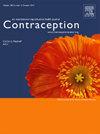Changes in contraceptive method use, access, and experiences of care during a statewide contraceptive initiative
IF 2.8
2区 医学
Q1 OBSTETRICS & GYNECOLOGY
引用次数: 0
Abstract
Objective
To examine changes in contraceptive use, access, and care experiences during a statewide contraceptive access initiative, Delaware Contraceptive Access Now.
Study design
We used responses from the Delaware/Maryland Survey of Women at the early wave (November, 2016–March, 2017) and late wave (February, 2021–October, 2021). Our cross-sectional sample included 6467 respondents at risk of unintended pregnancy. We used logistic regression to examine changes in contraceptive outcomes, controlling for age, race/ethnicity, income, education, marital status, and employment. Using interaction terms between state and survey wave, we compared population-level changes in outcomes in Delaware to changes in Maryland, which did not implement a similar contraceptive initiative.
Results
The change in long-acting reversible contraceptive (LARC) use in Delaware compared to Maryland was estimated as a 2.8% point increase, but was not statistically significant (95% CI: −2.8, 8.3). Knowing where to get free LARC increased by 6.2% points (95% CI: 0.4, 12.1; p < 0.05) in Delaware compared to Maryland. Both Delaware and Maryland indicated substantial within-state decreases in reporting their doctor asked about plans for pregnancy (Delaware: −8.9% points; Maryland: −15.1% points), but the decrease in Delaware was significantly smaller: 5.6% points (95% CI: −0.9, 12.1; p < 0.1). Delaware also had a net decrease of 4.7% points (95% CI: −9.9, 0.5; p < 0.1), compared to Maryland, among those very or somewhat satisfied with their current method.
Conclusions
We observed a mixed picture of changes in contraceptive use, access, and care experiences during the program. Our findings will be useful to Delaware program administrators and others, including the federal government, as they adopt similar reforms.
Implications
We found that the Delaware contraceptive access initiative substantially increased knowledge of free LARC access and led to a relative increase in respondents reporting they had been asked about their pregnancy plans, compared to Maryland, but was not associated with other outcomes.
避孕方法的使用、获取和护理经验的变化。
目的:检查在全州范围内避孕措施的使用,获取和护理经验的变化,特拉华州避孕获取现在。研究设计:我们使用了特拉华州/马里兰州女性早期浪潮(2016年11月- 2017年3月)和晚期浪潮(2021年2月- 2021年10月)的调查结果。我们的横断面样本包括6,467名有意外怀孕风险的受访者。在控制年龄、种族/民族、收入、教育程度、婚姻状况和就业等因素的情况下,我们使用逻辑回归来检查避孕结果的变化。使用州和调查波之间的相互作用术语,我们比较了特拉华州和马里兰州人口水平变化的结果,后者没有实施类似的避孕措施。结果:与马里兰州相比,特拉华州使用长效可逆避孕药(LARC)的变化估计增加了2.8个百分点,但没有统计学意义(95% CI: -2.8, 8.3)。知道从哪里获得免费LARC增加了6.2个百分点(95% CI: 0.4, 12.1;结论:我们观察到,在项目实施期间,避孕药具的使用、获取和护理经历发生了复杂的变化。我们的研究结果将对特拉华州的项目管理者和包括联邦政府在内的其他人有用,因为他们采取了类似的改革。
本文章由计算机程序翻译,如有差异,请以英文原文为准。
求助全文
约1分钟内获得全文
求助全文
来源期刊

Contraception
医学-妇产科学
CiteScore
4.70
自引率
17.20%
发文量
211
审稿时长
69 days
期刊介绍:
Contraception has an open access mirror journal Contraception: X, sharing the same aims and scope, editorial team, submission system and rigorous peer review.
The journal Contraception wishes to advance reproductive health through the rapid publication of the best and most interesting new scholarship regarding contraception and related fields such as abortion. The journal welcomes manuscripts from investigators working in the laboratory, clinical and social sciences, as well as public health and health professions education.
 求助内容:
求助内容: 应助结果提醒方式:
应助结果提醒方式:


